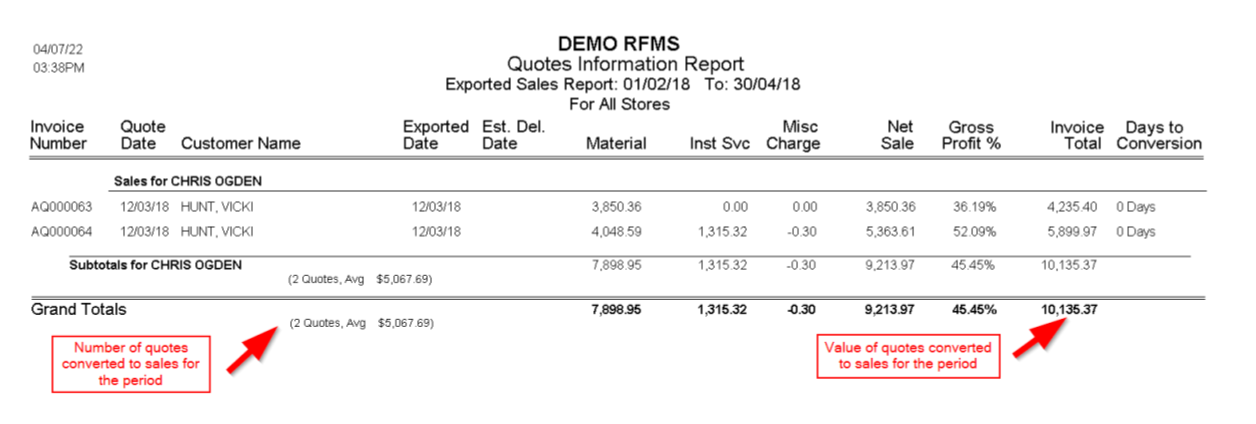Conversion Rate
Knowing our conversion rate gives us an insight into our sales performance. Conversion rate is fundamental to any sales organisation. We should know the overall conversion rate for our sales team and the conversion rate for each of our salespeople.
Understanding conversion rate gives us transparency even for our most successful salespeople.
Most flooring businesses measure conversion rate as a percentage of quotes. This ignores missed opportunities because we didn’t connect with the person when they were in our store. It also ignores those who took samples but chose not to go further with us.
We will discuss how we more effectively increase the number of people who get to the quote stage, so for the moment, we will work with the quote to sale conversion rate.
Conversion rate is the percentage of sales made relative to opportunities. If we quoted 100 projects and made 60 sales, our conversion rate was 60%.
We also want to understand our conversion rate in dollars; if those 100 opportunities represented $200,000 of potential sales and $100,000 converted into sales, our conversion rate was 50%.
Conversion Rate Forecasts your Future Business
By monitoring your conversion rate, you can predict the future performance of your business.
If the number of opportunities is down and your conversion rate slips, your pipeline will empty, so you can expect a revenue downturn in the coming weeks or months.
Monitoring your opportunities and your conversion rate is your canary in the mine.
If You Are Not Quoting in RFMS
To easily calculate our conversion rate, you will want all quotes generated by your sales team to come out of RFMS.
Some RFMS clients have their salespeople quote manually, maybe from a book of quote forms. When a job is won, it then goes RFMS as a sale. When this is the case, we have no transparency on the business we are losing.
We recommend that you have your salespeople quote out of RFMS.
Talk with us if you think getting your salespeople to generate quotes from RFMS will be difficult; it’s not. When you recognise the benefits of quoting out of RFMS for your business, you will easily overcome any resistance.
Let’s Put These into Action!
The following exercises help improve your conversion rate:
Exercise 1 - Management Exercise
Go to Order Entry/Reports/Quote Information Report and run a report for your sales team.
We want to get a snapshot of their sales activity, so select three months starting four months ago and ending one month ago. Select Salesperson/Customer number as the sort order.
You will want to print it out so you can look through it over a cup of coffee, but then run it a second time, outputting this time to a .csv file so you can put the data into our spreadsheet tool below. You will want to specify a file name and location as in the following image.
The first report is Quoted Sales Not Converted, and the second is Exported Sales (quotes converted to sales).
Note we don’t want our conversion rate to be skewed where multiple quotes have been generated for the same project. Salespeople should be using the Related Quote functionality to identify multiple quotes for a single project. For the purpose of the report, related quotes are not counted in either the quote numbers or the value of quotes. See this article at the RFMS Help Centre. (Contact us if you need a password to access the Knowledge Base).
In this example, the number of quotes for the period is 9 (two converted and seven unconverted), and the number of sales made for the period is 2; therefore, the conversion rate is 22.2% (2 divided by 9).
The value of all quotes (those not converted and those converted) for the period is $61,743.49, and the sales value for the period is $10,136.37; therefore, the conversion rate by value is 16.4% ($10,136.37 divided by $61,743.49).
We Have Made It Easier
Rather than manually calculate all these numbers, you can download a spreadsheet tool to help you more easily drill into your conversion rate.
Using the spreadsheet tool, check the conversion rate for each of your salespeople and then for all your salespeople combined.
The value of this information cannot be overstated. You cannot manage sales performance without it.
Some other things that can be gleaned from this report:
Gross profit. Can we see a pattern? For example, is the average GP% of jobs won lower than the average GP% of those not won? If so, your salespeople might be winning jobs on price, or maybe their quoted margin is too ambitious. Almost certainly, they are not following up.
The report gives you the average value for both converted and unconverted quotes. This number tells a story. Some salespeople are more comfortable working on small projects and unconsciously shy away from large ones. Conversely, some salespeople have no time for small jobs, instead focussing on the larger jobs that will give them the bigger sales numbers. Neither is good for your business, and coaching is required.
The number of quotes given by a salesperson can be interesting. If we have salespeople doing fewer quotes than other salespeople, we need to understand why. Are they letting opportunities slip through their fingers? How many people are they talking to? What are they doing with their time? How well are they interacting with customers at the early stages of the process? Are they following up on samples given out?
What is an acceptable conversion rate?
It will vary, but a good salesperson will achieve a 60-65% conversion rate. Anything less than 50% requires attention.
If a salesperson achieves more than 65%, we want to ensure they are not selling on price. Are they getting an acceptable margin? When a conversion rate reaches 65-70%, we should encourage the salesperson to increase their margin.
Shortly we will discuss how we can give our salespeople the tools to increase their opportunities and improve their conversion rate.
Exercise 2 - With Your Sales Team
At your next sales meeting, share the overall conversion rate achieved by the team and then share with each salesperson their conversion rate.
Put it into your diary to do this exercise at least once a month, sharing the results with your sales team.
exercise 3 - With Your Sales Team
Using the information from the Quote Information report, discuss with your salespeople those quotes that have not been converted. Do they know why? Is the opportunity lost? How diligent have they been with their follow-up?
Mining unconverted quotes is a crucial activity for successful salespeople.
exercise 4 - Management Exercise
When salespeople understand your focus on conversion, they may be tempted to game the system to report better results.
Look out for indications that your conversion rate is being gamed. A salesperson can generate a world-beating conversion rate by deleting quotes he knows he has lost.
To prevent this, you will want to password protect the Delete key in Quotes.






